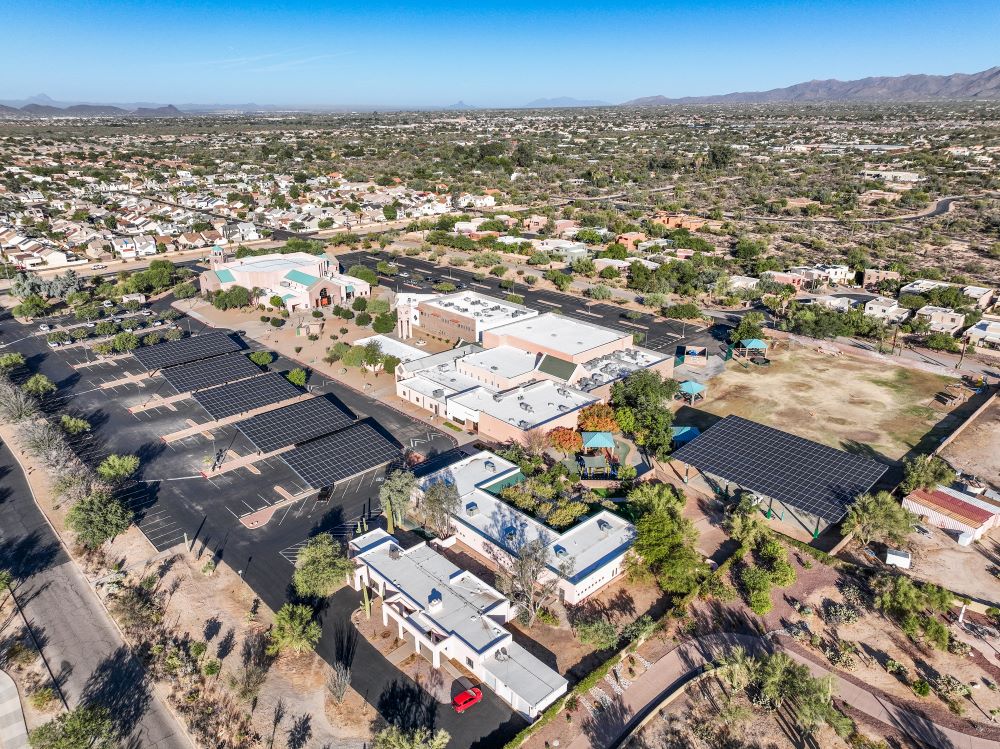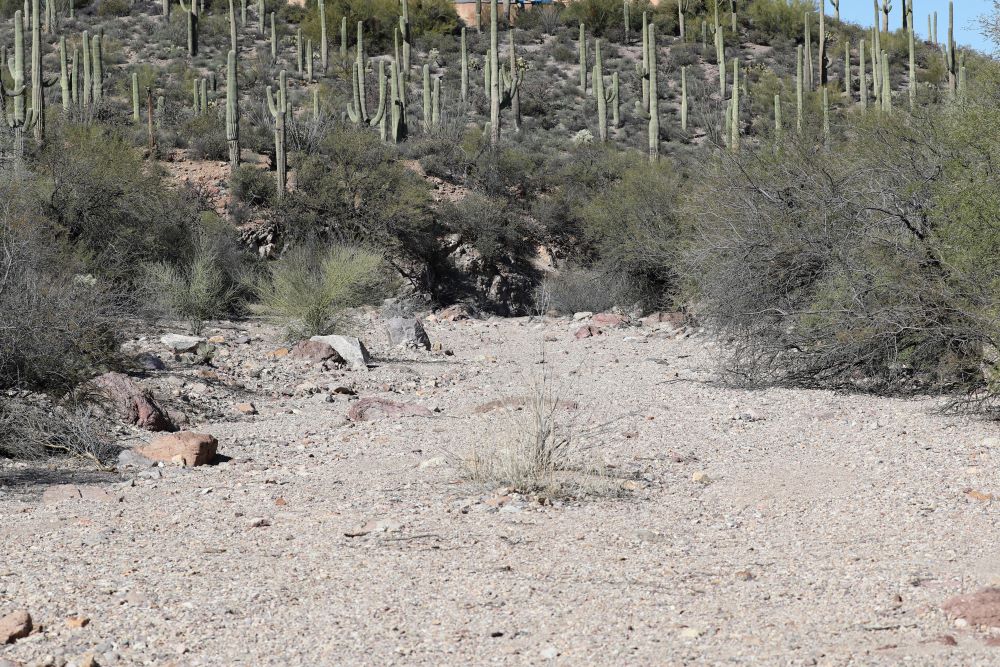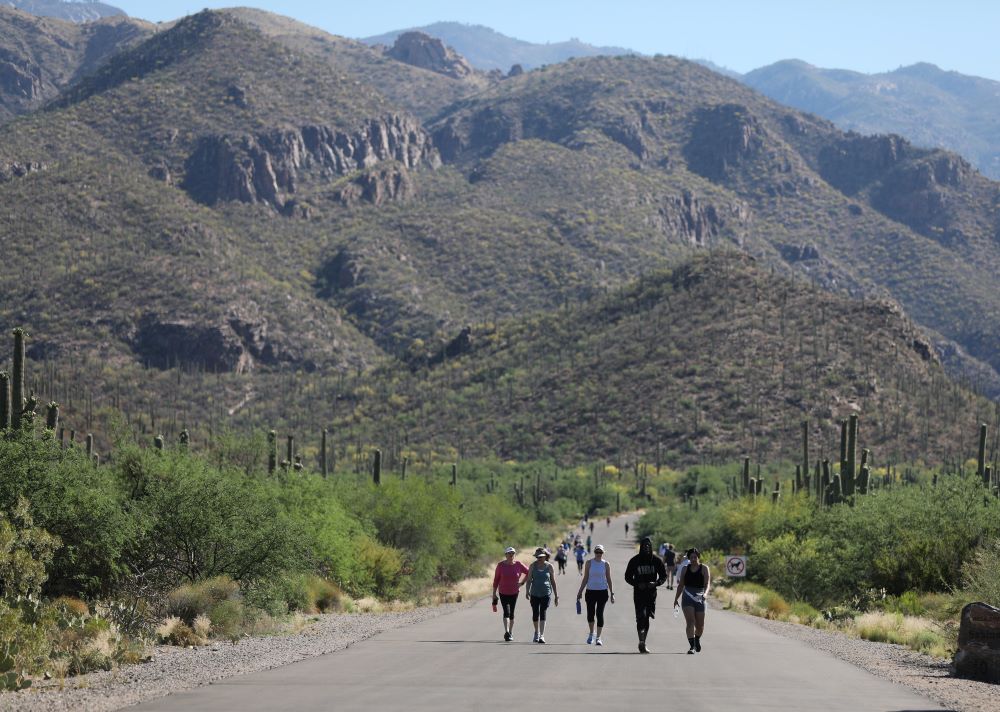
Solar panels cover parking spaces and a basketball court at St. Elizabeth Ann Seton parish in Tucson. Installed in 2023, the solar array provides 83% of the electrical demand for the church and school. Twelve of 77 parishes in Tucson Diocese have installed solar power systems. (Courtesy of Ed Lucero)
There are many things that make the city of Tucson, Arizona, well known. Its stunning landscapes. Its vibrant Mexican-American culture. It's home to the University of Arizona, fascinating museums and a thriving arts and cuisine scene.
It also has sunshine. And lots of it.
Boasting upwards of 350 days a year with clear skies, it lays claim as one of the sunniest cities in America.
While the searing desert sun can pose unsafe and hazardous living conditions, its intensity provides its residents, including more and more the Diocese of Tucson, with an increasingly valuable resource — solar power.
"Going solar at this point is really good ecology," said Bishop Edward Weisenburger. "But it's also good finance."
To the bishop, harnessing the energy-generating power of the sun offers a two-level lesson in stewardship.
'We're really called to be stewards of God's creation, not abusers. … We're to be blessed by creation — but we're also supposed to build it up, and leave it in good shape for the future generations.'
—Bishop Edward Weisenburger
"The first is, when we look at the book of Genesis, we're really called to be stewards of God's creation, not abusers. We're not to use it as we please, in our own time, to please ourselves," Weisenburger told EarthBeat. "We're to be blessed by creation — but we're also supposed to build it up, and leave it in good shape for the future generations."
"I think we also have an obligation to use the gifts entrusted to us, the tithes by the good faithful," he added. "And I honestly think that these efforts that we're undergoing right now are good, not only for the world from an ecological perspective, but also from a financial perspective."
To date, 12 of 77 parishes have installed solar power systems in the Tucson Diocese, the country's fifth-largest diocese by land, covering nearly 43,000 square miles across southern Arizona.
The gradual shift to solar began in 2008 when Our Mother of Sorrows Catholic Church became the first in the diocese to tap the power of the sun. Others have followed, with interest growing since Weisenburger became Tucson's seventh bishop in 2017.
One factor triggering the diocese's growing adoption of solar power the bishop isn't shy to name: climate change.
Bishop Edward Weisenburger has led the Tucson, Arizona, Diocese since 2017. (OSV News/Courtesy The Register)
"When I got here — almost seven years ago — the people who'd been here for a long time told me, 40, 50 years ago during the monsoon season, it literally rained every afternoon; that was normal," Weisenburger recalled. Fast downpours, in particular, have been typical of the region's climate.
"Our climate has changed, remarkably," he said. "We're seeing here what's being seen all over the world, for the most part — that there's a change going on."
This year, Tucson has had 92 days above 100 degrees Fahrenheit — less than the blistering stretch in Phoenix of 113 consecutive days with the mercury over 100, but still 20 days more than normal.
Pima County, which includes Tucson, has confirmed 152 heat-related deaths so far in 2024, while in Maricopa County, which includes Phoenix, the death toll is 256, with another 393 cases under investigation.
The heat also impacts water access. In March, Arizona State University’s Arizona Water Innovation Initiative said the state "is already experiencing more frequent and intense droughts, a shrinking snowpack, and groundwater depletion, alongside persistently high agricultural demand and growing urban demand."
The ways climate change is impacting Arizona have motivated the Tucson Diocese to look for ways to reduce its heat-trapping greenhouse gas emissions, whether through solar energy, Weisenburger driving an electric vehicle or his advocacy for state and federal environmental policies.

A dried-up creek bed is pictured along Camino de Oeste Trailhead in Tucson, Ariz., Jan. 28. This year, Tucson has had 92 days above 100 degrees Fahrenheit." Experts say climate change in Arizona is causing more frequent and intense droughts and a shrinking snowpack, (OSV News/Bob Roller)
Motivation has also come from Pope Francis.
"He doesn't just point out what the environmental scientists are pointing out — critical and important as that may be — but in Laudate Deum he calls our journey toward better stewardship a pilgrimage of reconciliation with the word that is our home," Weisenburger said. "He's going further than just pointing out the problem. He's pointing out there's a better way to live — and that's something we all need to hear."
Parishes see solar savings
In addition to moral and scientific rationales, the shift to solar has presented economic advantages for parishes as well.
One of the diocese's largest parishes, St. John the Evangelist Catholic Church, on Tucson's south side, has saved 30% on electric bills after installing solar panels, a significant decrease in utility costs that previously ran $10,000-15,000 a month.
Corpus Christi Catholic Church, a smaller parish without a school, installed solar in 2012, and now fully owns its system. It too has seen its electric bill slashed by tens of thousands of dollars annually.
The diocesan chancery has followed suit, in 2024 installing a large solar array that is expected to supply 95% of the power demand for the chancery and the adjacent St. Augustine Cathedral campus. Precise figures are not yet available for the cathedral project, since it went online only weeks ago. The diocese anticipates significant savings on its energy bill.
"Our decision to go solar has brought about significant positive impacts for our parish. We have begun to significantly reduce our carbon footprint with our solar panels," said Fr. Alan Valencia, cathedral rector and diocesan vocation director.
Valencia told EarthBeat that savings tied to the new solar installation — powering the church, cathedral office and chancery — will allow the parish to better allocate its resources, with funds that were previously consumed by electric bills now available for ministries.
"The solar panels have also provided a significant amount of shade for our community in the high temperatures of Arizona," he said, referring to the elevated, ground-based panels.
"This shift to solar energy," Valencia added, "has not only been beneficial for the cathedral, but has also reinforced our intention of being other-centered, using our energy in the best possible way, and inspiring others to make a difference in our community and the world."
St. Elizabeth Ann Seton parish, in northwest Tucson, in 2023 installed solar panels over a basketball court and parking spaces. The system covers 83% of the church and school's electricity needs, while providing the added benefit of cooler kids and cars.
"Bishop Weisenburger for years has promoted the use of solar in the diocese — he's urged the pastors to look into it," said Fr. Ed Lucero, pastor at Elizabeth Ann Seton and the diocese's vicar general and moderator of the curia.
He said the solar array has helped control the parish's utility costs, a priority for every parish and especially important for large congregations like his. The new system has lowered its energy bill $4,000 to $5,000 a month.
"It's pretty significant," he said.
Guided by a 'solar sherpa'
Recently retired, John Shaheen wore many hats in his 22 years with the Tucson Diocese. A property director, insurance director, risk manager and facility manager, he oversaw 24 major building projects totaling more than $67 million.
An unofficial title was "solar sherpa."
"I share with them what I know," Shaheen, still speaking in pre-retirement tenses, said of discussing solar's potential. "To see if I can encourage them or discourage them from going into it — and I've done both."
In Tucson, Catholic parishes generally have two installation options. In one case, it owns the solar power system, managing the project from start to finish and paying for all associated costs and future maintenance. Or it may lease parish property to investors who work with a solar company that installs panels and handles repairs.
In owning the system, a parish doesn't have to pay for the electricity generated — an alluring prospect — but they must retire the construction debt, which can be "a big outlay of money," Shaheen said.

People walk through Sabino Canyon Recreation Area, at the base of the Santa Catalina Mountains. in Tucson, Ariz., May 21, 2023. In the Tucson Diocese, an area that experiences extreme heat and lots of sun, 12 of 77 parishes have installed solar panels. (OSV News/Bob Roller)
Through a lease, investors own the system, often with little upfront cost to the parish. The investor makes money from the electricity the solar array generates while the parish receives a locked-in lower energy rate. The investors also took advantage of tax incentives that weren't accessible to nonprofit entities, but a provision under the Inflation Reduction Act allows faith institutions and other nonprofits to receive tax credits directly for qualifying energy projects.
Not all parishes are candidates for a lease agreement, with size and generating capacity two key factors, Shaheen said.
"A lot of parishes don't generate enough electricity, because they're small," he said. "They say daily Mass, so the church is being heated or air conditioned only for an hour or two a day. … They can't generate enough money to make it worthwhile for the investors," he said.
Parishes with schools and many ministries operating all day are more enticing for investors.
"You need an active church," he said.
Advertisement
Parishes meeting that description often see immediate savings in the first year, though Shaheen cautions their energy bills don't disappear.
Ground-based solar panels are most popular in the Diocese of Tucson, with only new constructions considered for rooftop panels. On terra firma, the panels are free of potential structural complications rooftop or elevated panels may pose — a situation that closed one Tucson parish for almost a year when its older roof couldn't bear the load the panels placed on it.
Shaheen advises any diocese considering solar installations for its parishes and properties to work with a reputable firm with experience with major installations. "A company that you know is going to be around for the next 20 years," he said.
Weisenburger offered another piece of counsel.
"I encourage everybody to look at how they can make an impact," he said. "And if you're not sure how to do it, talk to the young. They'll have an answer for you."




